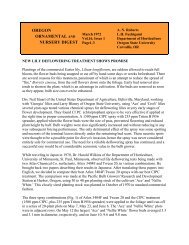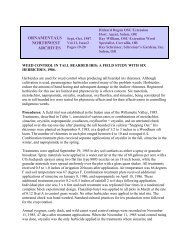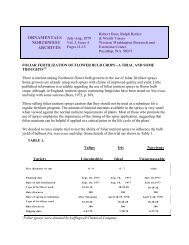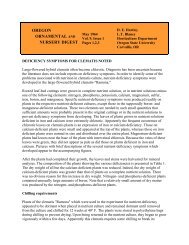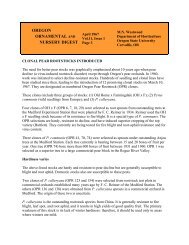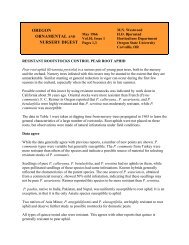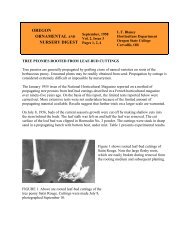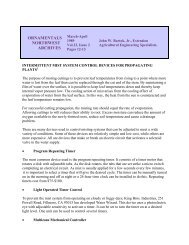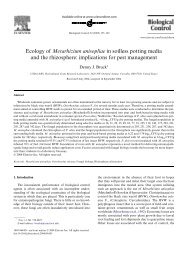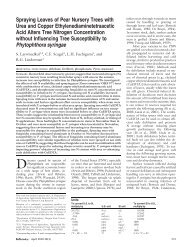Douglas-Fire Needle Midge.....Determining a Spray Schedule ...
Douglas-Fire Needle Midge.....Determining a Spray Schedule ...
Douglas-Fire Needle Midge.....Determining a Spray Schedule ...
Create successful ePaper yourself
Turn your PDF publications into a flip-book with our unique Google optimized e-Paper software.
Biological Control<br />
"...about 75 percent of the overwintering midge larvae were parasitized by Platygaster<br />
sp."(Condrashoff, 1962). The parasite larva develops slowly and overwinters inside the midge<br />
larvae. The following spring, before the midge larva pupates, the parasite develops rapidly and<br />
makes a cocoon from the midge larva's skin. The adult parasite emerges several weeks after<br />
emergence of the adult midge. However, Contarinia pseudotsugae, the most common midge on<br />
the <strong>Douglas</strong>-fir, apparently resists parasitism to some extent by encapsulating parasite eggs in the<br />
body with a sclerotized layer that prevents hatching. Even so, parasitism may destroy a large<br />
proportion of the midge larvae (Condrashoff, 1962). The delayed emergence of the parasite in<br />
the spring (parasite emerges several weeks after the adult midge emerges) is another reason for<br />
trapping so chemical spray application can be closely timed to coincide with peak emergence of<br />
adult female midges. <strong>Spray</strong>s should not be applied so late as to miss the adult female midge and<br />
wipe out the later emerging parasites.<br />
References:<br />
Condrashoff, S.F. 1962. Bionomics of three closely related species of Contarinia Rond.<br />
(Diptera: Cecidomyiidae from <strong>Douglas</strong>-fir needles. The Canadian Entomologist 94(4):376-394.<br />
Nagel, N.P. 1968. <strong>Douglas</strong>-fir needle midge control. Northwest Lookout, Nov. 1968.<br />
Pesticide Use - Due to constantly changing laws and regulations, no liability for the suggested use of chemicals in<br />
this Newsletter is assumed by the ONW Newsletter. Pesticides should be applied according to label directions on the<br />
pesticide container.<br />
Permission to Reprint material appearing in the ONW Newsletter is granted with the request that you credit the<br />
source: Ornamentals Northwest Newsletter, date, volume, issue, page numbers. Do not excerpt or reprint in such a<br />
manner as to imply the author's endorsement or criticism of a product or concept.<br />
Nondiscrimination - The information in the Ornamentals Northwest Newsletter is provided with the understanding<br />
that no discrimination is intended and that listing of commercial products implies no endorsement by the authors.<br />
Criticism of products or equipment is neither intended nor implied.





